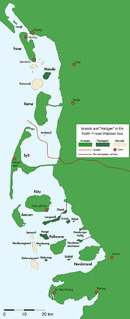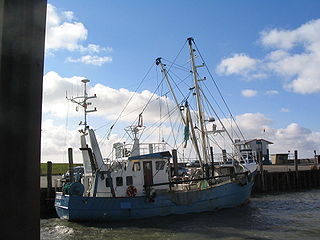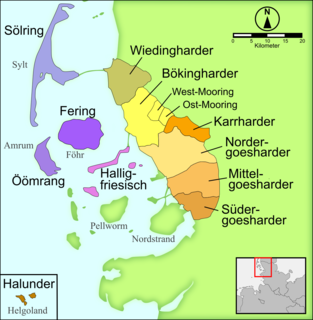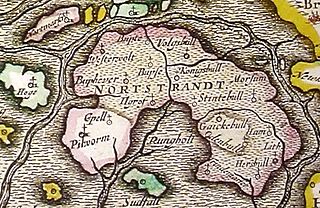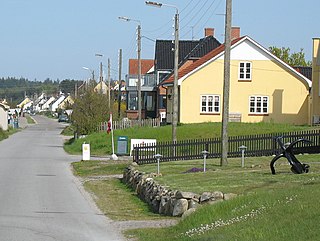
Lundenberg Hundred (German : Lundenbergharde; Danish : Lundebjerg Herred, older: Lundæbyarg Herred) was a mediaeval hundred located in the southern part of North Frisia in the Danish region of Southern Schleswig, part of the Frisian Uthlande. Lundenberg Hundred was one of the so-called Five Hundreds or Strand Hundreds on the island, the others being Edoms Hundred, Beltring Hundred, Southern Goes Hundred, and Pellworm Hundred. It encompassed the southeastern part of the former island of Strand, between what are now the peninsulae of Nordstrand and Eiderstedt.

German is a West Germanic language that is mainly spoken in Central Europe. It is the most widely spoken and official or co-official language in Germany, Austria, Switzerland, South Tyrol (Italy), the German-speaking Community of Belgium, and Liechtenstein. It is also one of the three official languages of Luxembourg and a co-official language in the Opole Voivodeship in Poland. The languages which are most similar to German are the other members of the West Germanic language branch: Afrikaans, Dutch, English, the Frisian languages, Low German/Low Saxon, Luxembourgish, and Yiddish. There are also strong similarities in vocabulary with Danish, Norwegian and Swedish, although those belong to the North Germanic group. German is the second most widely spoken Germanic language, after English.

Danish is a North Germanic language spoken by around six million people, principally in Denmark and in the region of Southern Schleswig in northern Germany, where it has minority language status. Also, minor Danish-speaking communities are found in Norway, Sweden, Spain, the United States, Canada, Brazil, and Argentina. Due to immigration and language shift in urban areas, around 15–20% of the population of Greenland speak Danish as their first language.
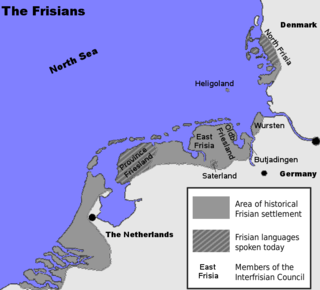
North Frisia or Northern Friesland is the northernmost portion of Frisia, located primarily in Germany between the rivers Eider and Wiedau/Vidå. It includes a number of islands, e.g., Sylt, Föhr, Amrum, Nordstrand, and Heligoland.
The hundred was split in two as a result of the Grote Mandrenke in 1362. The towns of Ham and Lith, located north of the Heverstrom tidal creek, became part of Edoms Hundred. These towns were flooded and sank into the sea along with most of the island of Strand itself during the Burchardi flood of 1634. The southern part of the hundred did not entirely sink in the storm, but was nevertheless heavily damaged by waves, which completely destroyed the towns of Lundenberg and Padelack.

A tidal creek, tidal channel, or estuary is the portion of a stream that is affected by ebb and flow of ocean tides, in the case that the subject stream discharges to an ocean, sea or strait. Thus this portion of the stream has variable salinity and electrical conductivity over the tidal cycle, and flushes salts from inland soils. Tidal creeks are characterized by slow water velocity resulting in buildup of fine, organic sediment in wetlands. Creeks may often dry to a muddy channel with little or no flow at low tide, but with significant depth of water at high tide. Due to the temporal variability of water quality parameters within the tidally influenced zone, there are unique biota associated with tidal creeks which are often specialised to such zones. Nutrients and organic matter are delivered downstream to habitats normally lacking these, while the creeks also provide access to inland habitat for salt-water organisms.

Edoms Hundred was a mediaeval hundred located in the southern part of North Frisia in the Danish region of Southern Schleswig, part of the Frisian Uthlande. It encompassed the eastern part of the island of Strand, which sank in 1634 during the Burchardi flood, including some of the land which now comprises the peninsula of Nordstrand. Edoms Hundred bordered the other so-called Five Hundreds or Strand Hundreds on the island: Beltring Hundred to the north, Pellworm Hundred to the west, Southern Goes Hundred to the east, and Lundenberg Hundred to the south.

The Burchardi flood was a storm tide that struck the North Sea coast of North Frisia and Dithmarschen on the night between 11 and 12 October 1634. Overrunning dikes, it shattered the coastline and caused thousands of deaths and catastrophic material damage. Much of the island of Strand washed away, forming the islands Nordstrand, Pellworm and several Halligen.
Today, remnants of the old hundred are now part of the island-turned-peninsula of Nordstrand, as well as the site of the town of Simonsberg, Germany, located southwest of Husum.

Simonsberg is a municipality in the district of Nordfriesland, in Schleswig-Holstein, Germany.

Husum is the capital of the Kreis (district) Nordfriesland in Schleswig-Holstein, Germany. The town was the birthplace of the novelist Theodor Storm, who coined the epithet "the grey town by the sea". It is also the home of the annual international piano festival Raritäten der Klaviermusik founded in 1986.

